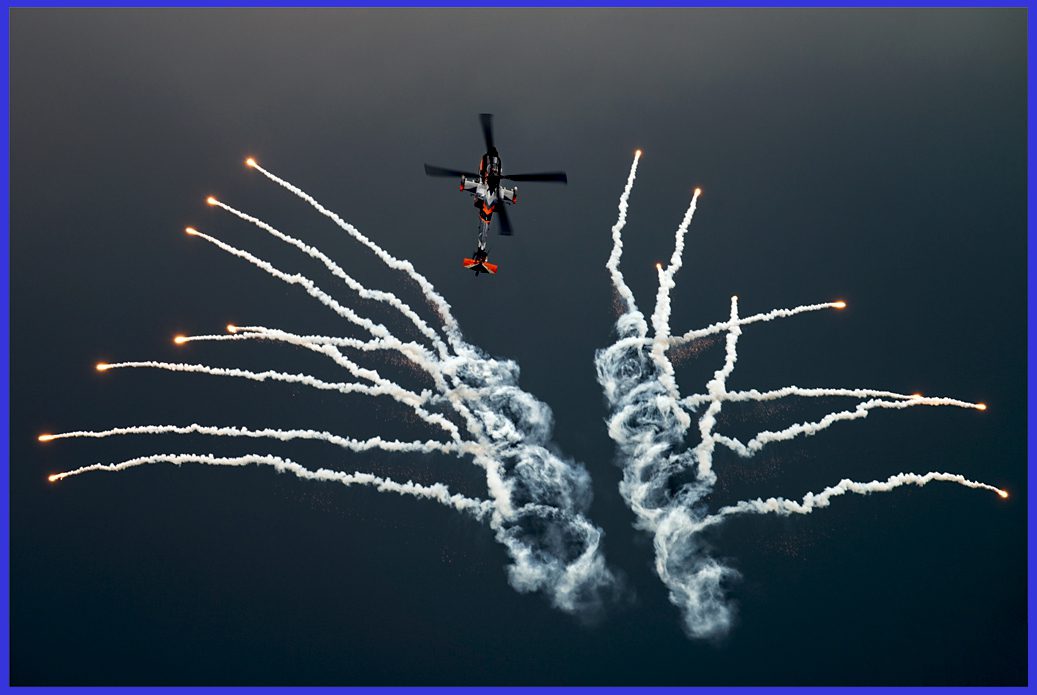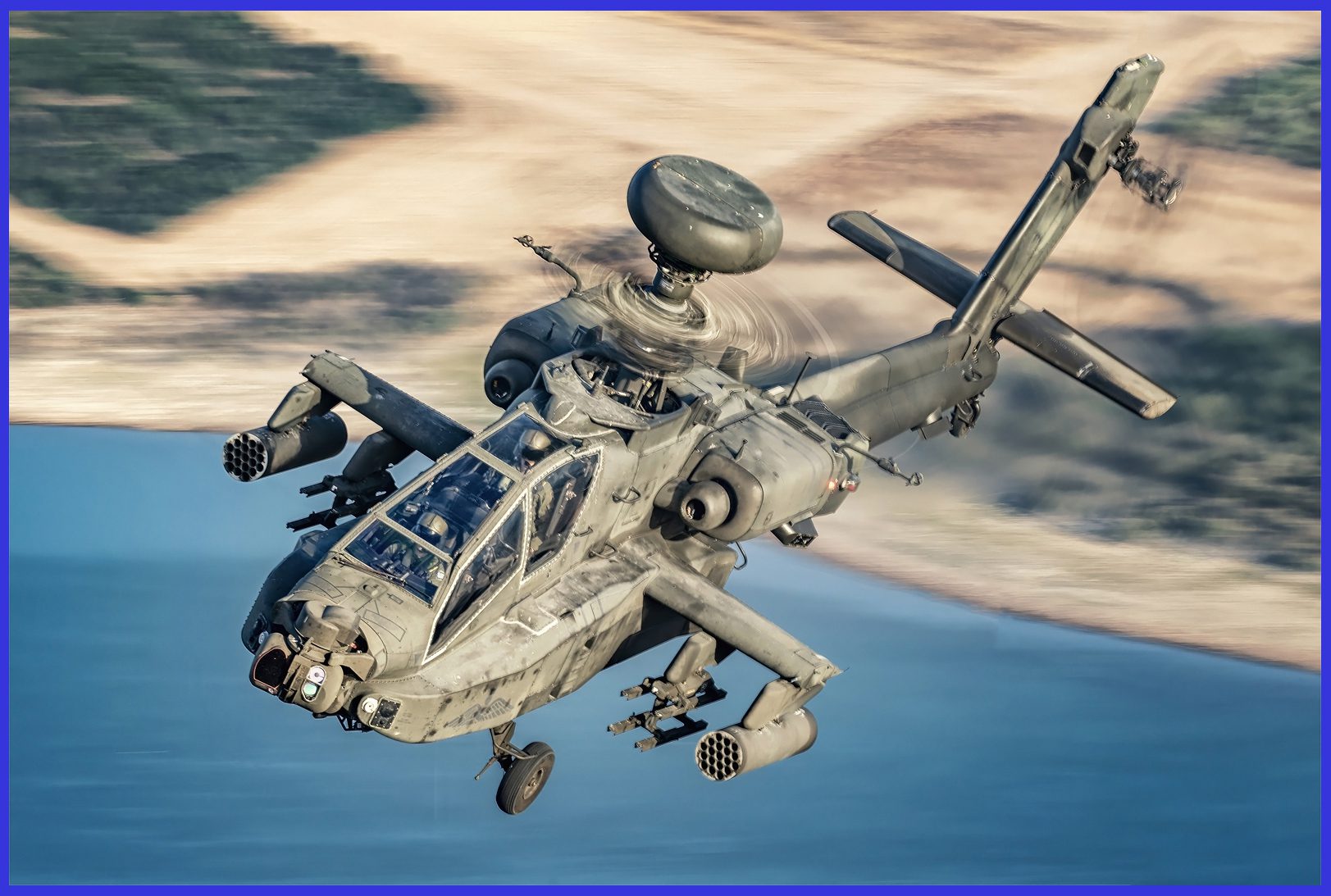A versatile and robust design attack helicopter presently developed by Boeing Defense, Space & Security (BDS), the AH-64 Apache stands as an awe-inspiring testament to advanced engineering and cutting-edge technology. Let’s Delve into the Best of the AH-64 Apache Helicopter, an extreme machine meticulously designed to unleash devastating precision strikes deep behind enemy lines. Its versatile capabilities extend to armed reconnaissance and security operations, overcoming challenges posed by day, night, or adverse weather conditions.

Equipped with state-of-the-art avionics, formidable weapons systems, and enhanced survivability features, it reigns as an unstoppable force on the modern battlefield. With continuous upgrades and unmatched performance, the Apache stands as a vital and indomitable guardian, defending nations and ensuring the safety of ground forces worldwide.
The Apache is primarily designed for close combat and armed reconnaissance missions, serving as an attack helicopter with the capability to engage and eliminate enemy armour, vehicles, and personnel. However, to ensure its survivability even in the most challenging combat scenarios, the Apache features advanced armour protection that can withstand small arms fire and certain anti-aircraft threats. Additionally, it incorporates a range of measures to enhance survivability, such as infrared countermeasures, radar warning systems, and chaff/flare dispensers.

It features a distinctive tandem-seat cockpit for a pilot and gunner, enhancing crew coordination. With a length of approximately 58 feet and a Main rotor diameter of 48 feet, the Apache is powered by twin turboshaft GE-701 engines, providing a top speed of around 182 mph. Its robust design includes advanced avionics and sensors, including a target acquisition and designation system, enabling precise targeting in various environments. Armed with a 30mm M230 chain gun, the Apache also carries a mix of AGM-114 Hellfire and Stinger missiles and Hydra 70 rockets, offering formidable air-to-ground capabilities.

Renowned for its agility, firepower, and survivability, the AH-64 Apache remains a cornerstone in modern military aviation, serving in the armed forces of 18 nations worldwide, including the U.S., Greece, Japan, Israel, India, the Netherlands, Singapore, and the United Arab Emirates. It has also been built under license in the United Kingdom as the AgustaWestland Apache, with a total of 2,400 units produced as of April 2020.
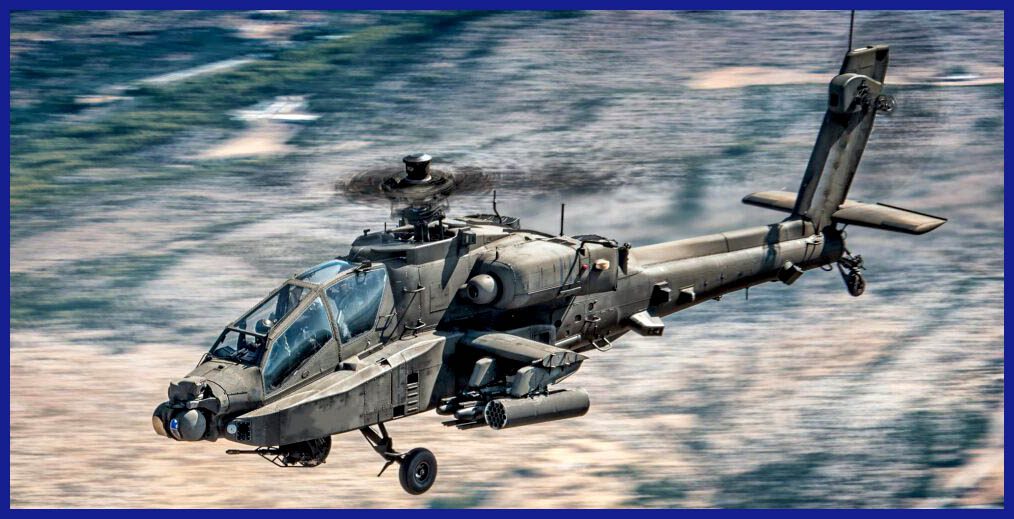
Background of the AH-64 Apache: An Advanced Attack Helicopter
The AH-64 Apache is a renowned attack helicopter developed by Hughes Helicopters (later acquired by McDonnell Douglas, now part of Boeing). Designed as the Hughes Model 77, the YAH-64A first flew on September 30, 1975. It is a two-seat rotorcraft with a slim fuselage, a prominent fin with a low-mounted elevator, and stub wings. Introduced into service with the United States Army in 1986, the Apache has become a vital component of many military forces globally. It was designed to address the need for a dedicated anti-tank helicopter capable of providing close air support and conducting armed reconnaissance.

The AH-64 was designated as the Apache in late 1981, inspired by the Apache tribe, in adherence to the tradition of naming Army helicopters after Native American tribes. It received approval for full-scale production in 1982. Subsequently, in 1983, the initial production helicopter of the ‘A’ variant was unveiled at Hughes Helicopter’s facility in Mesa, Arizona.
Following Operation Desert Storm, a proposed upgrade to 254 AH-64As was introduced as the AH-64B. The envisioned improvements included new rotor blades, a Global Positioning System (GPS), enhanced navigation systems, and new radios. Unfortunately, the upgrade plans faced cancellation in 1992, primarily due to funding issues. Similarly, after 1993, the ‘C’ designation was also cancelled.
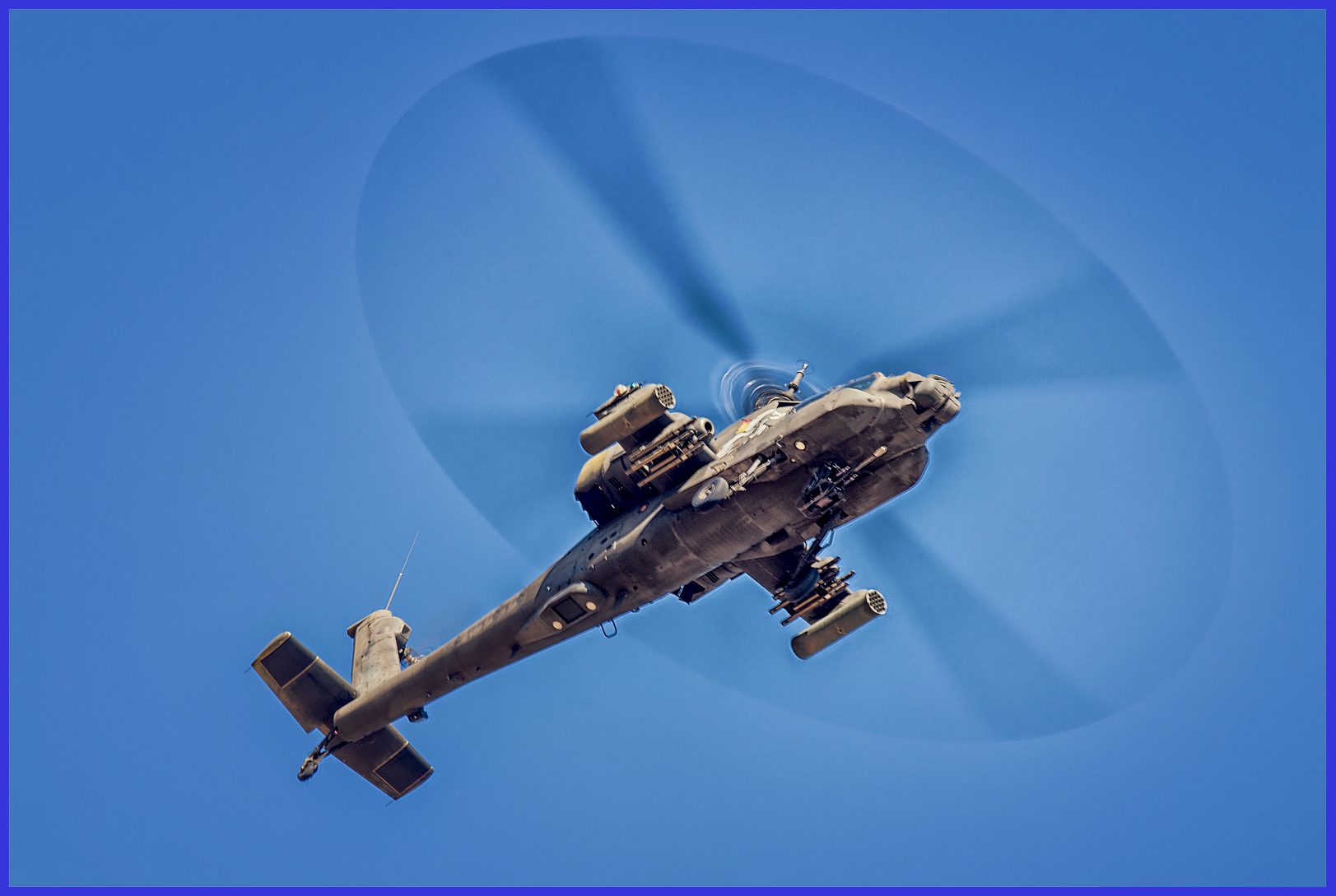
The later development of the AH-64D Apache Longbow was approved by the Defense Acquisition Board. The first AH-64D prototype flew on April 15, 1992. Prototype testing concluded in April 1995, featuring a mast-mounted Longbow radar, increased power, enlarged fuselage side fairings, and more sophisticated avionics. During testing, six AH-64D helicopters were compared to a larger group of AH-64As. The results demonstrated a sevenfold increase in survivability and a fourfold increase in lethality for the AH-64D compared to the AH-64A.
Based on these results, full-scale production was approved in October 1995, and a five-year contract was signed in August 1996 to upgrade 232 AH-64As into AH-64Ds. Additionally, Westland is manufacturing it as the WAH-64D Apache AH.Mk 1 for the British Army, powered by RTM322 engines.
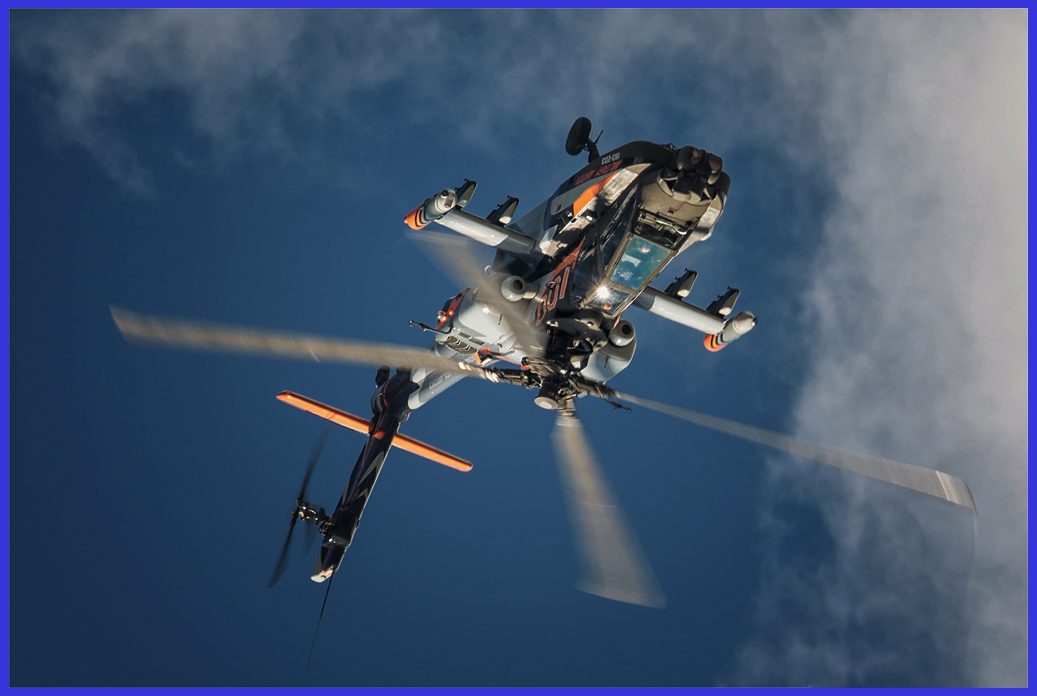
The Cutting-Edge AH-64E Apache: The Latest Variant in Attack Helicopter Technology
Rebranded as AH-64E Guardian in 2012, it was previously identified as AH-64D Block III. The AH-64E showcases enhanced digital connectivity, incorporates the Joint Tactical Information Distribution System, boasts more robust T700-GE-701D engines coupled with an upgraded face gear transmission to accommodate increased power, possesses the capability to control unmanned aerial vehicles (UAVs), demonstrates full IFR (instrument flight rules) capability, and features upgraded landing gear.
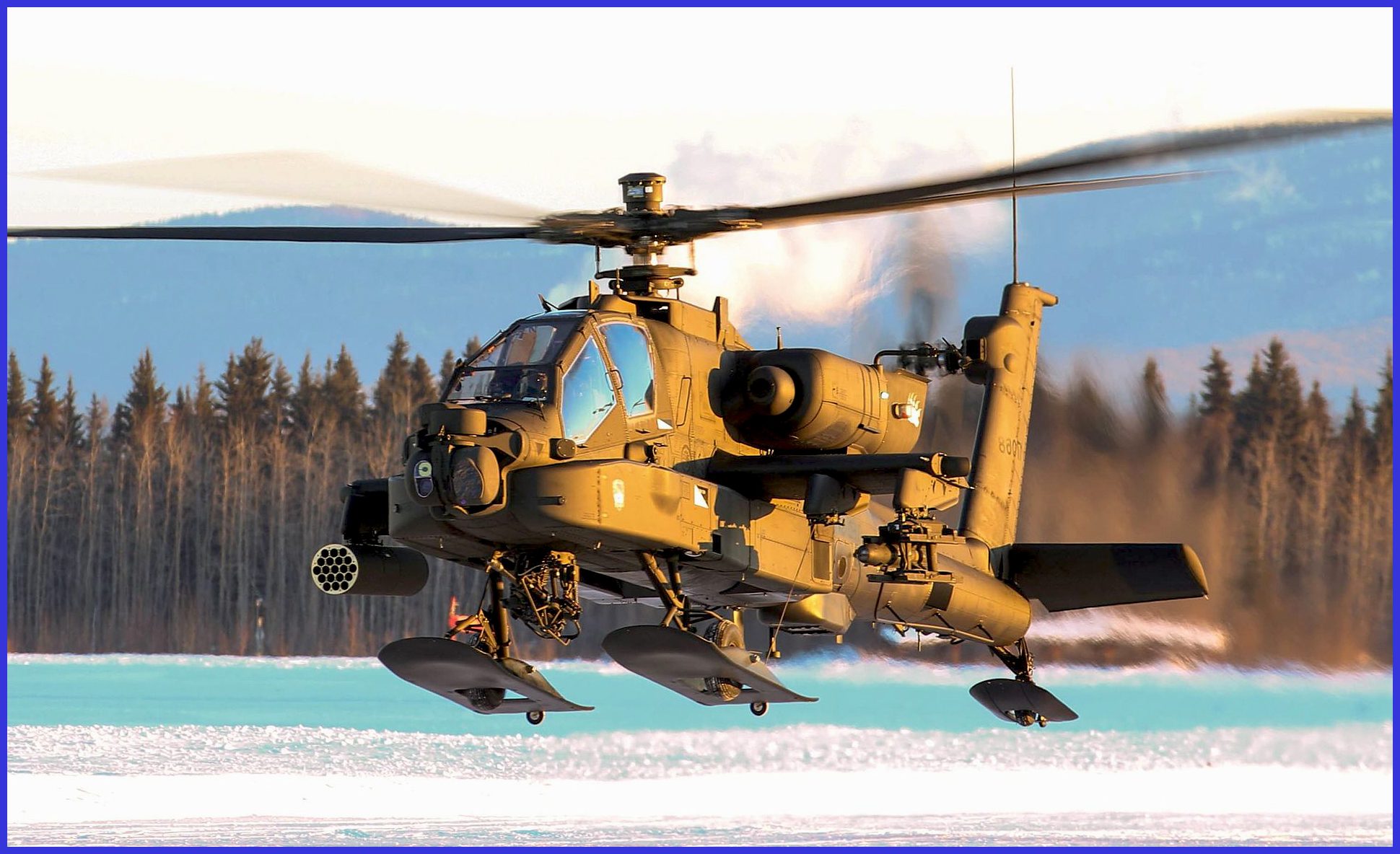
The AH-64E cockpit is redesigned to digitize and multiplex all systems. MANPRINT (Manpower and Personnel Integration) principles ensure that crew stations have multi-function displays, reducing pilot workload and increasing effectiveness. The modernized Apache heavy attack team is now able to provide a truly “coordinated” rapid-fire capability, servicing 16 separate targets within one minute, to the manoeuvre force commander on a 24-hour basis in day, night, and adverse weather conditions.
In 2004, a set of new composite rotor blades, having completed testing, were introduced to enhance cruise speed, climb rate, and payload capacity. Full-rate production received approval on October 24, 2012, leading to the upgrade of 634 AH-64Ds into AH-64Es.
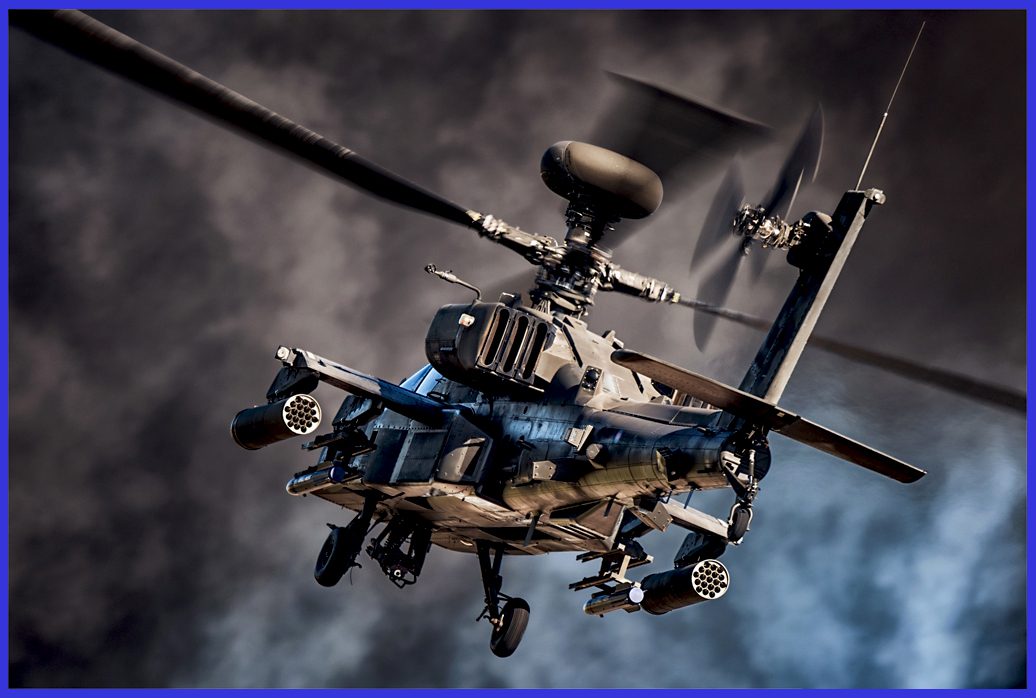
An Overview of the AH-64E Apache Design
The AH-64E Apache Guardian represents the latest variant of the iconic AH-64 attack helicopter, designed and manufactured by Boeing. Here’s an overview of its design:
Fuselage: The Apache features a streamlined and robust fuselage, offering tandem seating for both the pilot and co-pilot/gunner. The stepped cockpit design optimizes visibility for both crew members. Notably, both crew members can independently pilot the aircraft and operate weapon systems. The crew compartment and rotor blades are precisely engineered to withstand impacts from 23 mm rounds.
The airframe includes 2,500 pounds (1,100 kilograms) of steel armour protection and integrates a self-sealing fuel system designed to defend against ballistic projectiles. Additionally, this compartment includes a transparent blast shield positioned between the pilot and gunner seats, ensuring the potential survival of at least one crew member in the event of a direct hit.
The MIL-STD-1290 crashworthiness standard, which outlines the minimal requirements for crash impact energy attenuation to reduce crew injuries and fatalities, was met by the aircraft throughout its design. This achievement was realized by incorporating a fuel system, crash-worthy landing gear, seats, and greater structural strength.
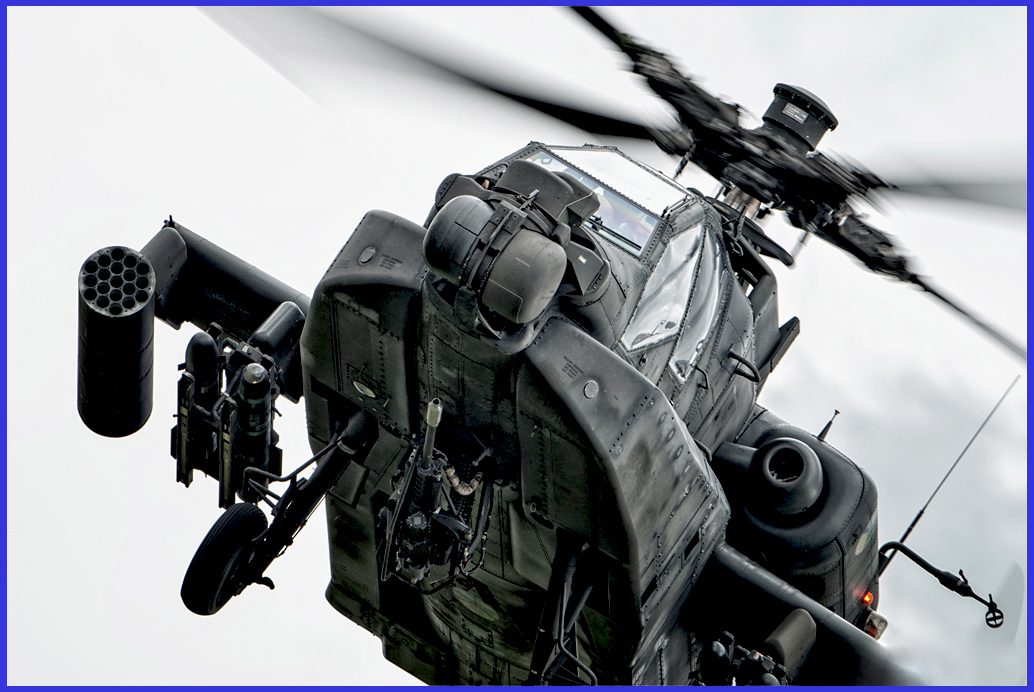
Rotor System: The AH-64E features a four-bladed main rotor and a four-bladed tail rotor, ensuring outstanding agility and manoeuvrability across various mission profiles. The incorporation of composite rotor blades is intended to improve cruise speed, climb rate, and payload capacity, thereby enhancing the helicopter’s overall performance capabilities.

Powerplant: The AH-64E is powered by twin General Electric T700-701D turboshaft engines, providing ample power for its missions. These engines contribute to the helicopter’s speed, agility, and endurance. However, various models of engines have been used on the Apache; those in British service use engines from Rolls-Royce. From 2004 onwards, General Electric Aviation began producing more powerful T700-GE-701D engines, rated at almost 2,000 shp (1,500 kW) for AH-64Es.
On a typical day, with temperatures recorded at 59 °F (15 °C), the AH-64 exhibits an impressive vertical rate of climb, reaching 1,775 feet per minute, and boasts a commendable service ceiling of 21,000 feet (6,400 m). However, on a hotter day, when temperatures rise to 70 °F (21 °C), the helicopter experiences a reduction in its vertical rate of climb, diminishing to 1,595 fpm. Simultaneously, the service ceiling is decreased to 19,400 feet (5,900 m) due to the lower density of the air in warmer conditions.

Sensors: The helicopter is equipped with the AN/APG-78 Longbow fire control radar, delivering advanced target acquisition and tracking capabilities. The Apache Longbow represents a development and acquisition program for a millimetre-wave radar air/ground targeting system capable of operating day and night, in adverse weather, and through battlefield obscurants.
The Longbow program primarily involves the integration of a mast-mounted millimetre-wave fire control radar (FCR), a radar frequency interferometer, and a radar frequency fire-and-forget HELLFIRE missile on the Apache. Longbow’s digitized target acquisition system provides automated functions such as detection, location, classification, prioritization, and target handover.

Cockpit: The glass cockpit of the AH-64E is furnished with cutting-edge avionics, encompassing multi-function displays, navigation systems, and advanced targeting systems. This modernized cockpit significantly enhances situational awareness and mission effectiveness. An innovative feature of the Apache is its helmet-mounted display, known as the Integrated Helmet and Display Sighting System (IHADSS).
With this capability, either the pilot or gunner can synchronize the helicopter’s 30mm automatic M230 Chain Gun to their helmet, allowing the gun to track head movements and point in the direction they are looking.

Armament: The primary armament of the AH-64 Apache includes the 30mm M230 chain gun mounted under the nose. On its stub wings, the helicopter can carry a versatile combination of air-to-ground weaponry, including a mix of AGM-114 Hellfire and Stinger missiles, along with Hydra 70 rockets. In June 2017, both the U.S. Army and Raytheon jointly announced the successful completion of the first-ever helicopter-based flight demonstration of a high-energy laser system from the AH-64.
Simultaneously, the British Apache successfully concluded testing of the MBDA Brimstone anti-armor missile. In January 2020, the U.S. Army publicly revealed its decision to equip AH-64E Apaches with the Spike NLOS missile as an interim solution to acquire new munitions with enhanced stand-off capabilities.

Notably, the AH-64E possesses the capability to control unmanned aerial vehicles (UAVs), employed by the U.S. Army for conducting aerial scouting missions. Apaches can request control of an RQ-7 Shadow or MQ-1C Grey Eagle from ground control stations, facilitating secure scouting via Link-16 datalink communications.
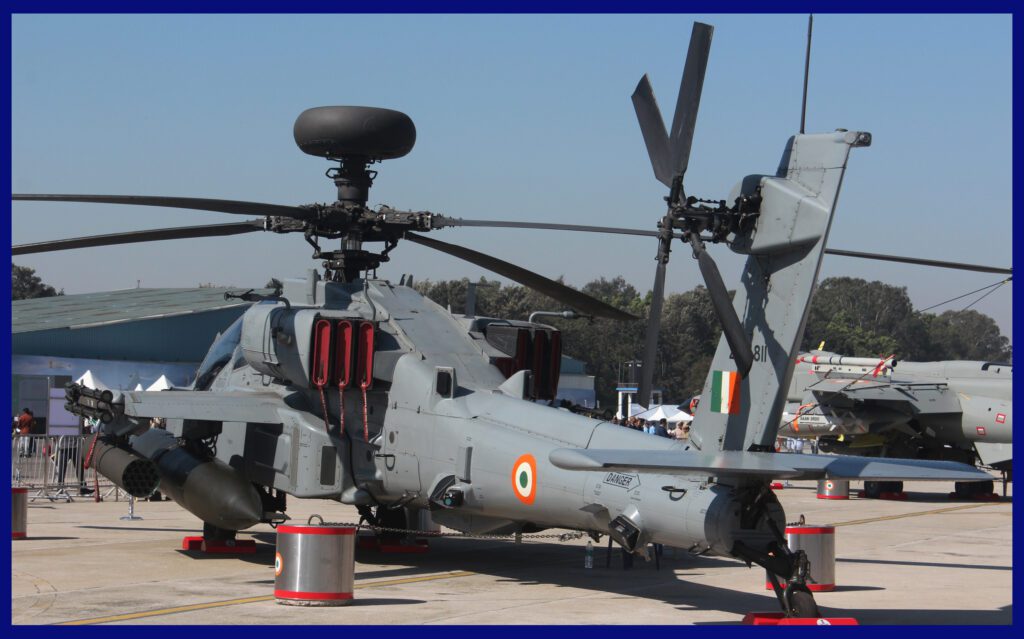
Introduction to the AH-64E Apache in India
In December 2010, India formally requested the sale of 22 Apaches along with the associated equipment. On October 5, 2012, IAF Chief NAK Browne officially confirmed the selection of the Apache. Subsequently, in 2015, India placed an order with Boeing for the acquisition of 22 AH-64E Apaches, as well as 15 Chinook helicopters. On May 11, 2019, India marked a significant milestone as it received its first AH-64E in a ceremony held at Boeing’s Mesa, Arizona facility.
By September 2019, a total of 8 AH-64Es were inducted into the IAF’s 125 Helicopter Squadron at Pathankot Air Base, Punjab. As of July 2020, all the Apache helicopters inducted into the Indian Air Force are accounted for in their inventory.
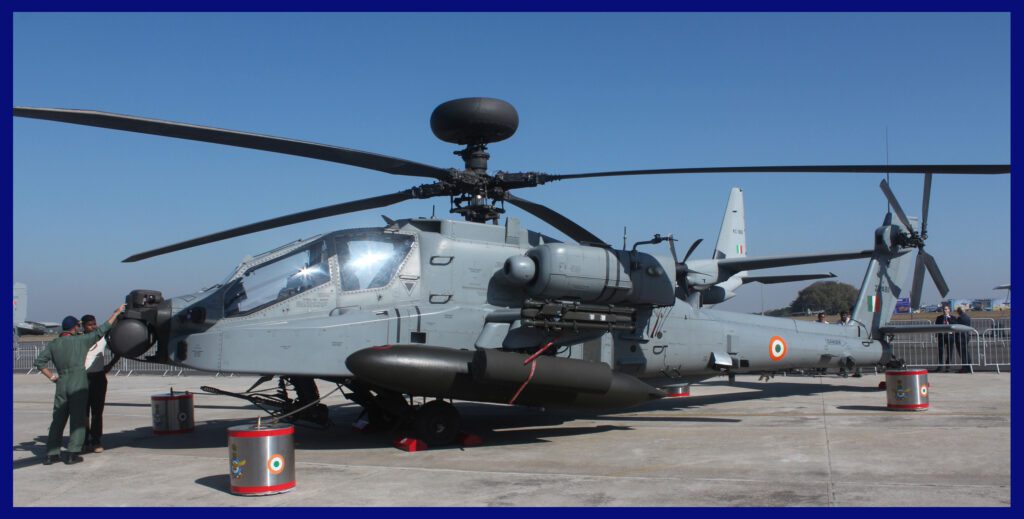
In February 2020, the Indian Army placed an additional order for 6 Apache helicopters, inclusive of weapons, equipment, and training. The commencement of deliveries is scheduled for 2023. These attack helicopters are strategically coordinated with squadrons of indigenous HAL Prachand attack helicopters. On January 1, 2024, senior Army officials disclosed to India Today that the Indian Army Aviation Corps anticipates the induction of the first batch of Apache helicopters in February-March of the same year.
This strategic deployment aims to provide the army with immediate firepower to safeguard its tanks on the battlefield, especially in situations where the Indian Air Force might be unavailable. Consequently, the Army Apaches are slated for deployment to Jodhpur, near the India–Pakistan border, significantly enhancing the security of the area against potential threats from Pakistani tanks.
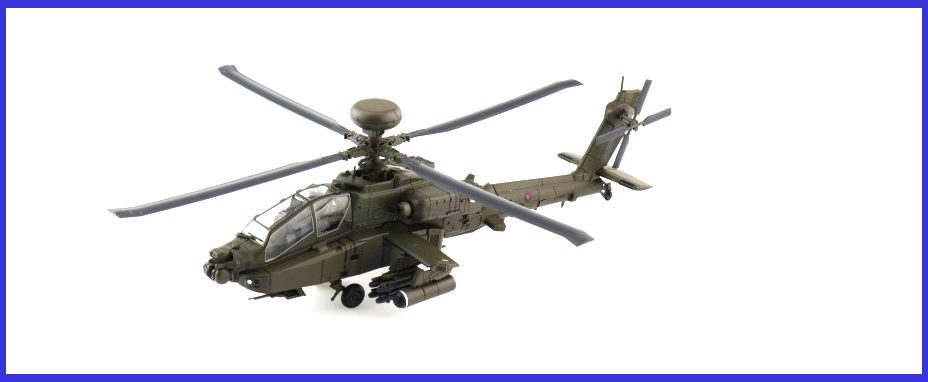
Specifications of the AH-64E Apache Helicopter
- Crew: 2 ( pilot & co-pilot/gunner)
- Length: 58 ft 2 in ( 17.73 m ) and only Fuselage length: 49 ft 5 in ( 15.06 m )
- Height: 12 ft 8 in ( 3.87 m )
- Weight: Empty_ 5,165 kg ( 11,387 lb ) Gross_ 8,006 kg ( 17,650 lb )
- Max takeoff weight: 10,433 kg ( 23,000 lb )
- Powerplant: 2 × General Electric T700-701D turboshaft engines, each providing 1,994 shp (1,487 kW)
- Combat Mission Speed: 167 mph ( 268.76 km/h )
- Combat Range: 482.80 km ( 300 mi )
- Ferry range: 1,896 km ( 1,178 mi )
- Service ceiling: 20,000 ft ( 6,100 m )
- Combat Endurance: 2.7 Hours
- Armament: One 30 mm M-230 Chain Gun with 1,200 rounds, plus it has 4 hardpoints on the stub wings; each point can carry Air-to-Ground Hellfire, Spike NLOS, Maverick, Brimstone as well as Air-to-Air Stinger (ATAS), and 70 mm Rockets

The Future Initiative for the Compound Apache
To increase lift and thrust, Boeing fitted a larger fixed wing and a pusher propeller to the Apache airframe, creating the AH-64E Block 2 Compound, which entered testing in October 2018. The engine’s exhaust was also redirected downward. The combined effects of these changes were expected to increase payload to 5,900 lb (2,700 kg), with improved fuel efficiency potentially leading to a maximum combat range of 460 nmi (850 km) and a speed of 343 km/h (213 mph).
In January 2019, a 30% scale model completed wind tunnel testing. Before the Apache is replaced as part of the Future Vertical Lift (FVL) initiative, the Compound Apache has been proposed as an interim replacement until a more comprehensive or long-term solution can be implemented.
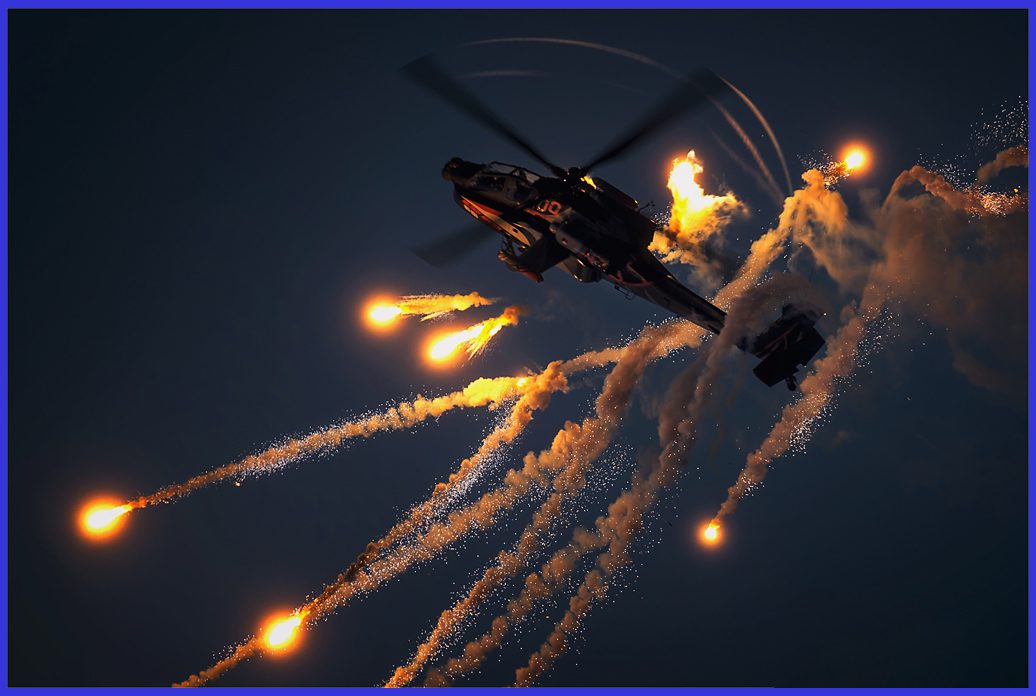
In conclusion, the AH-64E Apache helicopter represents the pinnacle of attack helicopter technology, delivering unrivalled combat capabilities, exceptional situational awareness, and enhanced survivability. Its advanced avionics, powerful weapons systems, and impressive performance make it a formidable force multiplier on the battlefield.
Whether engaging enemy armour, conducting armed reconnaissance, or providing critical air support, the Apache’s versatility and effectiveness make it an indispensable asset in modern warfare. With its continuous evolution and proven track record, the Apache stands as a symbol of technological excellence and a reliable guardian of ground forces worldwide.
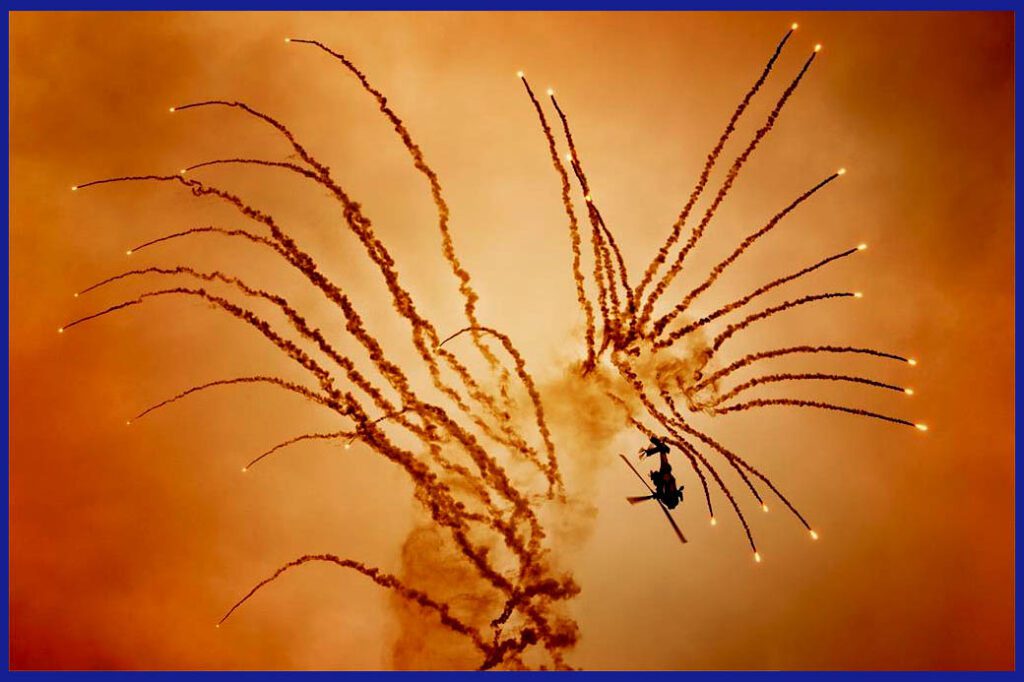
Important Announcement for Our Valued Readers!
After an article is published, it is possible that updates or changes may have occurred beyond the time of publication. Therefore, it is important to be aware that certain information in the article might be outdated. To ensure the most accurate analysis, it is highly recommended to verify the content with the latest sources available.
However, we are dedicated to delivering outstanding articles on military products and global updates. Maintaining quality and smooth operation requires resources. Your support sustains our efforts in providing insightful content. By purchasing high-quality products through our affiliated links, you help us keep our platform alive and acquire top-notch items. Your unwavering support is invaluable and inspires us to strive further.
We welcome your suggestions and requests for more information, as we value feedback from our readers. If there’s specific defence material or equipment not covered on our site, please share your request in the comments. We’ll strive to research and provide the required information. We sincerely thank you for your unwavering interest in our website, and we eagerly anticipate hearing from you! Enjoy your reading experience!
